This from Dan McInerney on a recent visit to CFD Engine 46’s house:
Plaque from the front of the firehouse. The first three names should look familiar to some of the more historically inclined.
Images from the house …
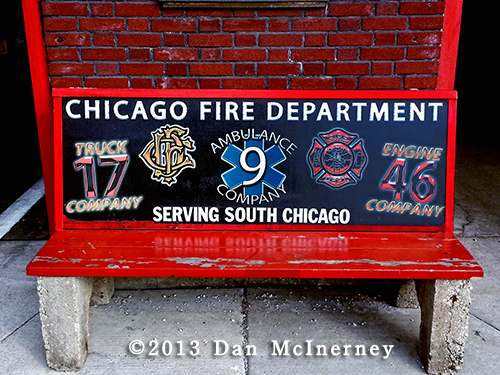
The decorated bench at CFD Engine 46’s house. Dan McInerney photo
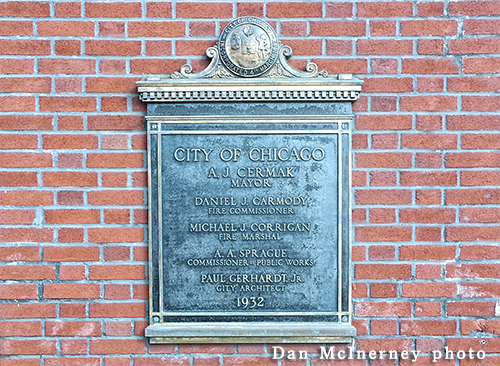
Memorial plaque at the firehouse of Chicago Engine 46. Dan McInerney photo
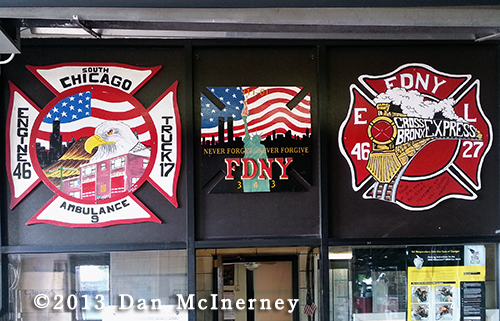
Logos for CFD and FDNY Engine 46. Dan McInerney photo
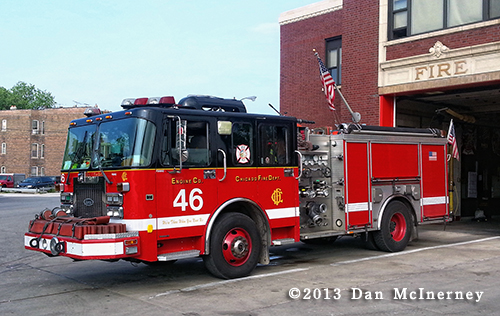
Engine 46 on the apron. Dan McInerney photo
… and what would a trip downtown be without stopping by Engine 98’s historic house
Engine 98’s house. Dan McInerney photo
Historic marker for the 100th anniversary of Engine 98’s house in 2002. Dan McInerney photo
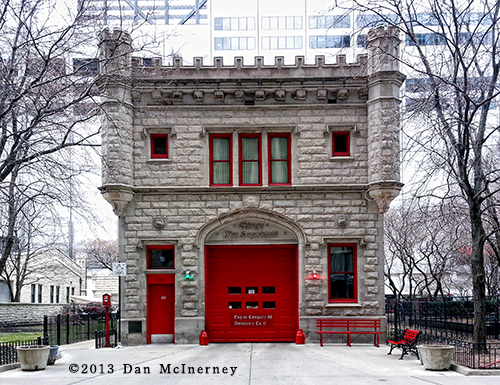
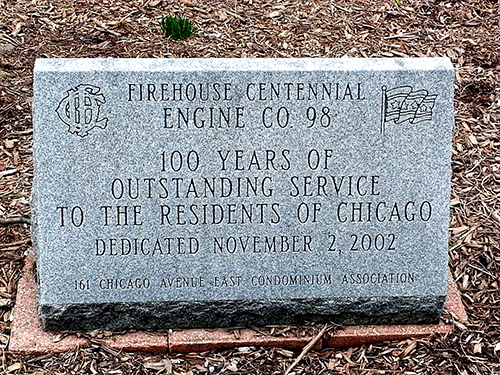






























#1 by Mary Hansen on July 16, 2016 - 4:51 PM
Can you tell me the address where the original Engine 46 Truck 17 was located? I know it was rebuilt in 1932 but I’m curious where the original firehouse was located. Can you give this information because I can’t find it anywhere. Please and thank you so very much!!
#2 by Mike Mc on June 18, 2013 - 8:28 PM
Webmaster(s): How about requesting inputs on suburban memorials and plaques for fallen firefighters? Just a thought. Thanks.
#3 by Mike Mc on June 18, 2013 - 8:22 PM
SS-3 was before my time Bill but I did have the opportunity to talk to Warren Redick, Bill Malone, and Jerry Becka about it. It was the busiest company in the U.S. one year – 1966? Decades after the fact, Chief Redick, was still upset how Commissioner Quinn would not purchase new rigs and the move to Engine 105 was a mistake.
Quinn, having never been on a squad, never understood that they should be strategically located. He was more concerned with filling an empty firehouse (SS-3, FMS 1, FMS 5, and FMS 6) or filling an empty bay in a large firehouse (FMS 3 and FMS 4).
DMc77: We strayed very far from your original post. Thanks again for the photos. Taking photos of CFD memorials would be great but I think suburban memorials would be even better because they are lesser known and we would like to learn more about them.
#4 by Bill Post on June 18, 2013 - 6:17 PM
Mike Mc while I wasn’t sure about the south end of SS 1’s still district , I do know that SS 1 went as far as Belmont on the northeast end of it’s district for many years. It went as far as Foster on the Still and Box however.
Mike do you recall the last year and a half that SS 3 was in service. They had still called it SS 3 until late 1968 when they finally started calling it Rescue 3 for the last 5 or 6 months before being taken out of service in May 1969. In September of 1967 they moved them to Engine 105’s former house on Erie east of Western avenue and it covered the near northwest side west of Ashland to at least Fullerton avenue on still alarms. During the days when Rescue (SS) 3 was in service at Engine 105’s old house SS 1 didn’t normally run west of Ashland as Rescue 3 was covering most of the old 4th Battalion.
Of course before May 1969 when Rescues ( SS) 2 and 3 were taken out of service , all three of the SS’s and or Rescue Squads would be dispatched on the 2-11 alarms city wide.
#5 by Mike Mc on June 18, 2013 - 3:53 PM
Mistake on my part. Without consulting general orders and just going by memory – SS-1 originally did not go south of Madison Street on a still alarm. About the same time they started going west to Kedzie they went south to Congress. In the late 1970’s they went as far south as Roosevelt Road. The still district also started creeping north, to at least Belmont and perhaps Addison.
#6 by Mike Mc on June 18, 2013 - 3:28 PM
Bill: A wealth of information, as always. Thank you.
If Superintendent McCarthy stays in Chicago long enough, I have no doubt he will eventually propose emergency services units for Chicago. The manpower shortage is probably holding him back. (If it works in New York, it must work anywhere … right? What do you mean this hick town has no E.S.U.’s?)
I believe Snorkel Squad 1 started going west to Kedzie on still alarms in late 1972 or early 1973. I was told that it had something to do with Ray Antunicci being assigned as Battalion 4. Even though SS-1 went as far west as Kedzie, they did not go south of Madison Street on a still until about 1977 when they went all the way to Roosevelt Road.
Although the 4th Battalion had a lot of fires, I always believed that the extended still district was a mistake. The rigs started to wear out, the firemen did too, and the apron runs (yes, they had them) increased. They should have responded only on working fires in the 4th Battalion, but that was a totally unheard of concept at the time. Either you responded on the still or you responded on the still and box. There was nothing in between. Some of the officers on SS-1 proposed the idea but it was rejected. One big problem was that there was no real captain of SS-1 at that time. Captain Windle was acting battalion chief most of the time.
Everyone forgets the role that the federal discrimination law suit played in the strike of 1980. The city did not hire or prommote firefighters for several years. That is when five man companies started becoming four and four man companies started becoming three. The senior firefighter was acting engineer or acting lietuenant, the senior lieutenant was acting captain, the captain was acting battalion chief, and the battalion chief was acting division marshall. They even had an acting chief fire marshall. I belive Bill Foley was acting for at least a couple of years before he became official.
Let me clarify an eariler comment. I think it is great that young firefighters take pride in being associated with the old squads and it was marvelous that Squad 2 invited old Squad 2 members to their reunion. The point that I am trying to make is the snorkel squads should not be forgotten. Unfortunately, they have been.
#7 by Bill Post on June 16, 2013 - 7:56 PM
Mike Mc , I’m glad that you brought up New York City’s Rescue companies which did predate Chicago slightly as far as far as being a Rescue company.
Another interesting thing about New York’s Rescue companies as opposed to Chicago’s Squads is that New Yorks Rescue companies were initially meant to function strictly as “fire” rescue companies in the strict sense of the word. The New York City Fire Rescue companies were established to Rescue trapped and overcome fire fighters and were amongst the first fire companies in New York to have air masks. They were really an early RIT team. They were used to rescue civilians in fires as well and while they may have been used at times for non fire rescues by the early’ 1930’s the New York City Police Department had formed their famous Emergency Services unit which had and does combine the functions of Police Heavy Weapons Unit (Swat team) and a Rescue Squad. The ESU units as they are called were used for many non fire rescues and medical emergencies before the arrival of an ambulance. So they had functioned much the Chicago Fire Departments Original Squad companies which did respond on non fire emergencies and EMS type runs by the 1930’s.
I know that for people outside of New York City it is difficult to imagine having was is in effect a Police Department Rescue Squad but in New York City they have had it for many years and there very first vehicle was on a fire engine open body “Squad” Chassis painted in New York City Police colors. The New York City Emergency Services Unit had begun as a RIot Control and Machine Gun Squad and took on the function of a Rescue Squad as well.
That explains why New York City which has three to four times as many people only has 5 Fire Rescue companies because for many years the non fire emergencies were handled by the Police Emergency Service Unit. Until the early 1950’s there were 20 Emergency Service Stations in New York City each with a Heavy Rescue type Truck. In the 50’s the Emergency Services Stations (which are in strategically located Police stations) were reduced to 10 ESU stations however at the same time smaller roving ESU patrol vehicles were put in service which today are called REPs which is short for Radio Emergency Patrols and they have any where from 2 to 4 REP units patrolling their districts.The REPS run with 2 men but if it is a major Emergency they will dispatch more then one unit and also dispatch one of 11 Heavy Rescue units.
Over the last 20 to 3o years as the fire rate in New York city has gone down like in Chicago and many other cities the New York city fire department has been responding to more none fire emergencies however in the 1960 and 1970’s which are nick named “the war years” when New York city had the highest fire rate in the country the New York City Fire Deparment had it’s hands full just responding to fires so the New York city Police Emergency Services unit handled most of the non fire emergencies. New York city runs with 11 Heavy Rescue style Police Squads about 20 to 40 smaller REP patrol trucks which is slightly larger then a Los Angeles County fire rescue squad and has more cabinet space. They also have a number of speciality vehicles that are used for Haz Mat calls and Constuction accidents and SWAT type of emergencies where weapons are involved.
I know that this sounds ridiculous and that in most cities the non fire emergencies are also handled by the fire department by in New York City both the Police and the Fire department handle non fire emergencies and each have their own “Squads”.
#8 by tom sullivan on June 16, 2013 - 6:18 PM
the only thing that made sense (in my opinion) in the formation of the flying squads was that they started out with an engine apparatus and carried one bed of 2 1/2″ hose, so they could lead out if first on the scene. they also had an engineer asigned. when they got the mack / platt squad rigs they had a booster tank and reel. (no engineer) these were removed later to cut weight because of the pounding on the streets & breakdowns.
looks like the old report came true with a 2 engine house, just a little farther north than recommended !
looking back it was like the tail was wagging the dog, as far planning went ,,,,,but it was a great time !
#9 by Bill Post on June 16, 2013 - 4:26 PM
Yes Tom I remember that very well when Engine 79 was moved up to the far northwest side and the CFD taking Engine 128 out of service altogether.
The consultant who had recommended putting the Flying Manpower Squads in service had also recommend that Engine 128 be relocated to Engine 83’s new quarters and that Engine 79 be taken our of service instead.
Engine 24 was the Engine that had been recommended to be put into what was to become Engine 79’s quarters at 6420 N Lehigh. That was besides the point however as the major point is that the 1968 study had recommended that Engine 83 be a double Engine station.
I also remember that for a short period of time Flying Manpower Squad 6 was following Engine 83 on still alarms but as you point out it didn’t last very long. They could have kept Salvage Squad 3 where they were originally at (Engine 83’s quarters) and Engine 83 and 78 would still have had a “Squad” to follow them on still alarms.
I had always thought that Salvage Squad 3 was moved into Engine 22’s house just to make them look like a full station, without any regard as to how busy Engine 22 was. I’m sure that you remember that SS 1 was not that far from Engine 22 and was only a few blocks east of Engine 4 and Truck 10, so Engine 22 had SS 1 to follow them on still alarms anyhow.
Another foolish move was when Salvage Squad 1 was taken our of service in May of 1969 which was done when Flying Squad 4 was put in service and by the end of 1969 all of the 6 recommended Flying Squads were in service.
Salvage Squad 1 had been recommended to remain in service downtown at Engine 42’s quarters. Considering that downtown is where many of the stores were it made sense to have a Salvage Squad downtown in addition to being in a central location in the city. The 1968 consultant study didn’t even recommend that Salvage Squads 2 through 7 be put in service so it was hard to figure out was Commissioner Quinn was thinking.
The 1968 study had recommended that all three Snorkel Squads be taken out of service but as you know Commissioner Quinn had kept Snorkel Squad 1 however that is something that I could at least understand.
The 1968 study had recommended that the new Flying Squads and that Salvage Squad 1 become (in effect) heavy rescue squads by carrying much of the equipment that the Snorkel Squads had carried on board. It took a few years for Commissioner Quinn to do that as if you recall when the Flying Squads were put in service in 1969 they were using mainly old pumpers with not much more then 6 air masks , a K-12 saw , a metal litter and a few lengths of hose on board. The Flying Manpower Squads didn’t get their “Heavy Rescue” rigs and equipment until in 1973 , four years after being put in service. For those 4 years before the Flying Squads were reequipped, Snorkel Squad 1 was in effect the only Heavy Rescue Squad in the city and responded city wide on all pin in accidents and other Physical Rescue runs. SS 1 was responding city wide on 2-11 alarms from the beginning and in those days 2-11 ‘s were much more common then today.
It took a follow up report in the early 70’s that had finally gotten Commissioner Quinn to reequip the Flying Squads with Heavy Rescue equipment and apparatus.
What was so ridiculous was that in 1967 and 1968 the remaining Squad companies were taken out of service by Commissioner Quinn to allegedly cut costs and save money and in less then 2 years the Flying Squads were put in service. They could have kept the Squad companies in service in the first place and they wouldn’t have had to create the new “Flying Manpower Squads”. It really seemed like the fire department didn’t know what it was doing or at the very least it was being managed in a very haphazard way.
Tom those miserable conditions that you describe in late 1970’s when sometimes companies that were supposed to be running with 5 men on them would only have 3 or 4 men at the beginning of the shift is what led to the fire fighters strike of 1980 and like it or not the fire fighters strike succeeded and finally got all of the Engines and Trucks back to where they all should have been in the first place (with no less then 5 men assigned to them).
#10 by tom sullivan on June 16, 2013 - 9:56 AM
bill,
it was an odd situation that had fms 6 only going to ashland av. they did not follow e-83, e-78, or e-55, those were supposed to be 5 man cos. along with t-22 & t-44. of course that did not always happen and by the late 70s’ hardly ever happened, occasionaly then we would start the day with only 3 men (total) until a “detail” could be sent from somewhere else. the concept of squad cos. “backing up” just didn’t happen. we would respond to the high-rises with 2 engines & 1 truck, (12 men). compared to the 3 engs 2 trks and ss response downtown, and the mega responses of today!
there was heavy fire activity in uptown / lakeview/ edgewater then. an “arson unit” did run out of e-83 for a short time also. e-59 came up to t-47 about 1978, which helped with coverage, a little.
it was ironic that the city had taken e-79 & e-128, t-43, sqd-4 out the area just when the fire activity was really going up ! then replaced them with a flying squad that didn’t cover half the area! they did try sending fms-6 on all of e-83 / e-78 still alarms for about a month or so, in the late 70s’, but the rig broke down from so many runs so much that they stopped that !
#11 by Bill Post on June 16, 2013 - 1:51 AM
Tom that’s exactly what I had in mind when writing about the different types of Squads the would all be responding on the same still alarms.
Yes I remember that area that you are talking about which would get all 3 types of Squads on the same still alarm. the area began on the west side of Ashland and on the south side of Belmont and it went to Fullerton on the south end and I believe the Chicago River on the west end. Even after Salvage Squad 3 was taken out of service that area that you are talking about would still get both Flying Squad 6 and Snorkel Squad 1 dispatched to the same still alarms.
In regards to areas with the same response that area that you are talking about was just about the only area that was getting a three Squad response on Still Alarms as SS1 was the only Snorkel Squad that had remained in service by then. There were several areas around the city that would get a two Squad response on the still alarms as a number of places would get both a Salvage Squad and a Flying Manpower Squad dispatched on the still alarms,
In those years Snorkel Squad 1 would respond as far west as Ashland avenue on Still alarms and would respond as far north as Belmont in addition to responding at least as far south as the Loop and perhaps a little further. Around 1976 when all of the Salvage Squad had been out of service for a few years already , SS 1’s still district was expanded greatly to the west in which it was given all of the (old) 4th Battalion district to respond to still alarms in as well the northern end of the old 18th battalion. SS 1 after late 1976 would respond as far west as Kedzie avenue on still alarms would go as far north as Diversey west of the river and at least as far south as Chicago avenue in the 18th Battalion. On some the of stills in the 4th Battalion they would respond with Flying Squad 5.
The main reason why SS 1’s still district was expanded is because in the mid 1970s the( Old) 4th Battalion was getting alot of working fires which many were caused by arsonists. An arson task force was established at the 4th Battalion headquarters (Engine 35’s station) and the 4th and north east section of the 18th Battalion would would 3 Engines dispatched automatically on still alarms. Both Engine 57 and Engine 43’s stations became double Engine stations when Engine 51 was moved into Engine 43’s station from Engine 47 ( on the south side) and Engine 24 was moved into Engine 57’s station from Engine 26’s new station on the west side.
During the 1960’s when Chicago had more the one Snorkel Squad in service and most of our Original Squads were still in service it was common in a few areas to get both a Snorkel Squad and a conventional Squad dispatch on the same still alarms. Snorkel Squad 1 would be dispatched to most of the same still alarms with Squads 10 and 1 and Snorkel Squad 2 would go on many of the same still alarms as Squad 3. Squad 3 and Snorkel Squad 2 were located only a mile and a half apart from each other with Squad 3 being located with Engine 61 which was the next fire station west of Engine 60 were SS 2 was located at.
Snorkel Squad 3 was somewhat different however as Snorkel Squad 3 had replaced Squad 7 and essentially took over Squad 7’s still district. Snorkel Squads 1 and 2 didn’t replace any conventional Squad companies like SS 3 did.
#12 by tom sullivan on June 15, 2013 - 7:39 AM
bill, compliments on your encyclopedic knowlege of the squads (& other cfd) history.
it was kind of strange when in the early 70s’ there would be 3 squads responding on the same still alarm in some areas. the area north & west of clybourn, ashland, and fullerton would get ss-1, fms-6, and salvage-3 (from e-22’s house)! the squad manpower outnumbered the 2 engines & 1 truck on the scene!
there may have been other areas with the same response.
#13 by Mike Mc on June 15, 2013 - 12:53 AM
You are absolutely correct Bill. The original Squads 1 and 2 went out of service in the late 1960’s and there is no connection whatsoever with the the current squads beyond having the same names. I believe the myth began to grow in popularity when the current Squad 1 moved to 13’s house and they posted photos in the new firehouse of Engine 13 and old Squad 1 at the old firehouse on Dearborn Street. It was reinforced about four years ago when Squad 2 had a reunion that included members of the old Squad 2 from Engine 34’s old firehouse.
The modern squads are really the ancestors of snorkel squads 1, 2, and 3. Former Commissioner Galante told me that his intent was to have three snorkel squads, just like in the 1960’s. He decided not to call them snorkel squads because of negative connotations with SS-1 being remembered as a prima dona company by some during the Robert J Quinn era.
While we are on the subject, FDNY’s Resuce 1 is still the first rescue company in the U.S. fire service. The original CFD squads were only used for manpower. They were all placed in busy single engine houses shortly after the two platoon system went into affect. The purpose of the squads was to take a second hose line off of the steamer engines that had their manpower reduced because of the new 2nd platoon. Special tools and equipment came later.
Chicago’s squad and rescue history is very difficult to trace in comparison’s to New York’s rescue companies. About all you have to remember about New York is that Rescue 3 has sometimes been quartered in northern Manhattan and sometimes quartered in the Bronx and that Rescue 5 came and went in the 1950’s before becoming a permament fixture in the early 1980’s.
#14 by Al Whitlock on June 14, 2013 - 7:07 PM
Dan,
Thank you your for sharing your great photos. 2 years ago my son and I stopped by at E46 / L17. Some how they got my then 11 year old son to help mop the floor. They also let him help test the ladder. He even got to lower the jacks on the ladder. He had a blast and I got some great photos.
#15 by Bill Post on June 14, 2013 - 2:11 PM
Technically speaking Squad 1 and 2’s centennial was on January 15th. That’s the date that all three of Chicago’s Original squads were put in service.
They won’t be able to claim 100 years of continuous service either as the original Squad 1 was taken out service on February 2nd 1967 when they officially became Salvage Squad 1. Even if you count them as Salvage Squad 1 they were taken out on May 1st 1969.
After that Chicago didn’t have a Squad 1 until October 3rd 1980. Squad 1 (as we now know it) didn’t start running as a two piece squad with a Snorkel until September 19 1983.
The current Squad 1 is really closer in lineage to Snorkel Squad 1 (SS 1) which was in service from from September 12 1962 until October 3rd 1980.
The interesting thing about Chicago’s squad history is that Chicago had several different types and “eras” of squad companies which generally speaking were different fire companies. There were even times when Chicago had several different types and classifications of “Squad companies” that were in service simultaneously.
Chicago’s squads can be broken into these classifications.
1.The original squads which ran from 1913 until 1968.
2.The “Rescue companies” which ran from December 1929 until June 1933 and whose main purpose was to respond to “Special Duty” (EMS, physical rescues and non-fire emergencies) instead of the squad companies for the 3 years that the “Rescue companies” were in service.
3.The Snorkel Squads which ran from mid 1962 until mid 1980.
4.The Salvage Squads which ran from late 1966/early 1967 until late 1972.
5.The Flying Manpower Squads which ran from mid 1969 until late 1980.
6.The District squads which went in service on October 3rd 1980 and were numbered for the fire districts that they were assigned to. We ran a maximum of 7 District squads when in mid 1982 a new 6th District was created and a new Squad 4 was put in service. From September 1982 until September 1983 when half of the Squads in the city proper were taken out of service and the remaining 3 Squads (in the city proper) were made into today’s Snorkel squads.
Squad 7 at O Hare field was originally put in service as Squad 6 in February of 1982. It was a two-piece Snorkel squad and renumbered as Squad 7 in September 1982 when a new district was added.
Squad 7 remained a Snorkel squad until late 1988 when they received a Spartan/Supervac heavy rescue squad.
From mid 1969 until late 1972 the Chicago Fire Department was running with a Snorkel Squad, Flying Manpower Squads, and Salvage Squad companies at the same time. During 1970 they ran with Snorkel Squad 1, Salvage Squads 2 though 7 and Flying Manpower Squads 1 through 6 simultaneously. On November 16th 197, Salvage Squads 6 and 7 were taken out of service and Flying Manpower Squad 7 was put in service on the same day.
Snorkel Squads 2 and 3 were redesignated as Rescue Squads 2 and 3 from late 1968 until May of 1969 when they were both taken out of service. That was done because both companies were regularly running without Snorkels assigned to them during the last year that they were in service. Snorkel Squad 3 was actually running without a Snorkel from January 1967 until May 1969 so they really should have changed their designation much sooner.
Before the district squad companies were put in service on October 3rd 1980, Chicago’s squad companies (including the salvage squads) Flying Manpower Squads and Snorkel Squads) would be dispatched automatically went to fires in their still districts along with the still engine and truck companies without waiting for a confirmation of a working fire.
Before April 1955 Chicago’s squad companies were the department’s primary responders on “inhalator runs” which essentially were heart attacks, strokes and respiratory distress type runs. After April 1955 the squads would respond on those type of EMS runs second due (when the nearest ambulance wasn’t available) until they were taken out of service in the late 1960’s. The salvage squads would sometimes go on inhalator runs but not the Flying Squads or Snorkel Squads.
There is a significant difference between today’s squads and the first squads.
#16 by Danny on June 14, 2013 - 3:57 AM
Seeing the centennial marker reminds me that squad 1 has it’s 100th in sept I think they are doing something at quarters on the 13th of sept
#17 by DMc77 on June 13, 2013 - 9:44 PM
I did not although I have before. Time and a large group of people waiting to get on busses did not let me get over to that side. Although it gives me an idea to shoot the many CFD memorials around the city….
#18 by Mike Mc on June 13, 2013 - 9:24 PM
Thanks for the great photos. At the risk of being overly critical, did you take a photo of the Lt. Coglianese memorial outside Engine 98?